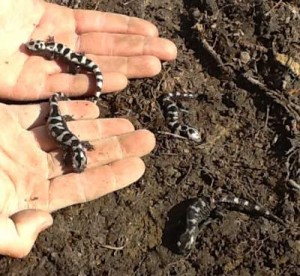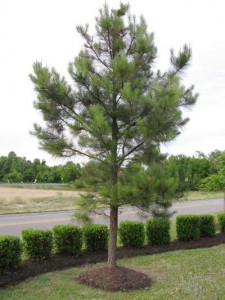
Marbled salamanders help aerate the soil
and build good soil structure.
Mulching correctly at the base of a mature tree is the single most important step that a home owner can take to improve a tree’s overall health. Good soil conditions for root growth are essential for a healthy tree. Mulching correctly is one step that can improve soil conditions. Incorrect mulching practices usually cause more harm than benefit.
The benefits of mulching correctly can hardly be overstated. To understand why mulching properly is essential to tree health and to our local ecosystem it may be instructive to imagine an early 17th century thunderstorm along the shores of the Chesapeake Bay.
During a summer storm, the forest canopy would intercept rain, reducing the speed of each droplet, slowly delivering the water to understory plants and protecting the permeable soil beneath from the harsh compacting effects of the driving rains. Rainwater trickling down the trunks of mature maples and venerable old oaks would slowly infiltrate the organic leaf litter and percolate throughout the soil, recharging the ground water and aquifers. After the storm clouds receded, the sun’s radiant energy would transform the remaining moisture on the foliage to water vapor and the water cycle would continue.
Excessive nutrients were rarely found on the forest floor as the local vegetation and microflora quickly absorbed the essential nitrogen. The forest canopy protected the life giving soils below and only small amounts of sediment would erode away into the local streams and rivers. Free of excessive nutrients and sediment, the Chesapeake Bay’s clear, shallow waters thrived with aquatic vegetation, providing critical habitat for the Bay’s vibrant and varied animal life.
Today, it’s easy to see how drastically we have changed the landscape. We have altered close to 95% of the land in the Chesapeake Bay watershed for industry, agriculture and living space. We have clearcut the forests and drained wetlands, criss crossed the land with wide swaths of impervious pavement, and overloaded croplands and lawns with nitrogen and phosphorous. Our technology and use of natural resources has afforded us a quality of life not seen by our predecessors. But this improvement has come at a cost to the ecosystem that sustains us. We can understand and account for that cost by educating ourselves about the roles our individual properties play in the overall ecology of the Coastal Plain and the Chesapeake Bay.
What Does This Have To Do With Mulch?
In our cities, agricultural fields, and suburban properties, we have effectively removed all of the natural organic layer—the decomposing wood, twigs, leaves, fruits and flowers—and replaced this detritus with non-native sterile lawns, fields, pastures, and pavement. This has a serious and negative impact on the region’s watershed hydrology. Watershed hydrology is the fancy term we apply to the cycle of rainwater, its movement and storage underground, its runoff into the waterways, and its return to the atmosphere via evaporation.
Mulching correctly has a positive impact on soil health and plant health, and consequently on watershed hydrology. Natural mulches improve soil fertility and soil structure. Good soil structure has large macropores that occupy approximately 50% of the soil volume. Ideal soil structure is rarely, if ever found in suburban settings because the soil has become severely compacted. As natural mulches break down, organic particles can infiltrate the soil and help microorganisms rebuild good soil structure. Improved soil structure allows the soil to absorb and hold more water and release water slowly to vegetation. When the soil absorbs more water there is less runoff, less erosion and less sediment polluting our waterways.
Additionally, applying a natural mulch 2 – 4 inches deep and as wide as practical will impede the growth of weeds, conserve soil moisture, moderate soil temperature extremes, and protect the trunk from serious damage from weed whackers and lawn mowers. Fine, absorbing tree roots are more abundant under 2 – 4 inches of mulch.
Improper Mulching

Correctly mulching requires avoiding “mulch volcanoes”
Unfortunately a common sight in Hampton Roads is incorrectly applied mulch. Oxygen is required for root respiration and piling mulch too high can limit the diffusion of oxygen in the soil. Piling mulch around the stem of a tree often leads to decay of trunk tissue and can create conditions that incite insect and disease problems. Deep mulch, or “mulch volcanoes” can provide shelter for small mammals that will chew the bark and girdle the tree. Additionally, thick layers of mulch can be become anaerobic or sour and become toxic.
If mulch is piled high against the trunk, it needs to be pulled away from the trunk and spread as broadly as possible. The broader the better. The base or root crown of the tree should be completely exposed. When applying mulches always use proper technique.
The correct application of mulch more closely mimics the natural forest environment. Mulching correctly will improve the health of individual trees, add beauty to your landscape and improve your property’s contribution to the local ecosystem.
